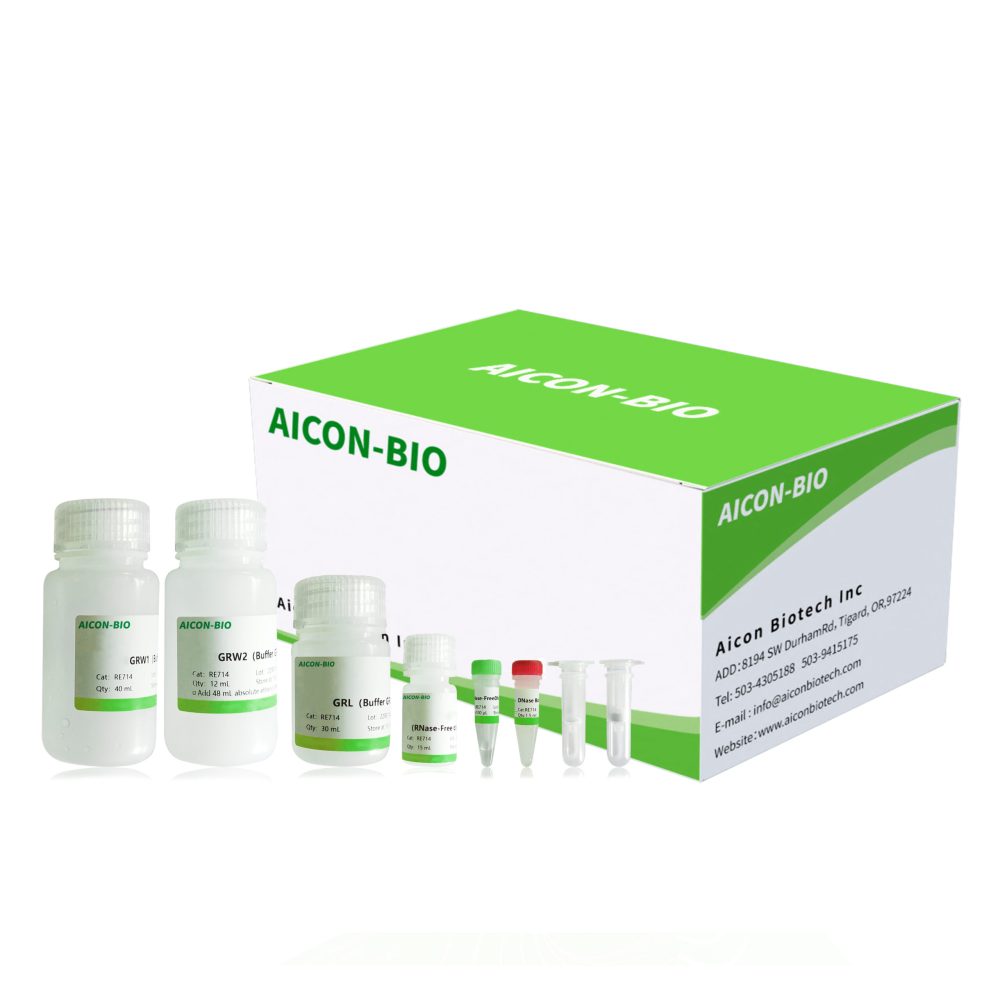AICON-BIO™ Plant Total RNA Extraction Kit (Centrifugal Column Type)
| Catalog Number | Unit Size | |||
| AIRE714 | 50 preps |
Introduction
This product is suitable for rapid extraction of total RNA from 50-100 mg plant tissue. The kit is based on
silica gel column purification technology, no need to use toxic phenol-chloroform extraction during the
extraction process, and the entire extraction process only takes 30-40 minutes. The kit adopts membrane
filtration and DNase I digestion, which can remove genomic DNA more efficiently. The extracted total RNA
is of high purity and basically free from protein and other impurities. It can be directly used for RT-PCR,
Northern Blot, Poly A purification, nucleic acid Protection and in vitro translation experiments.
Highlights
- Safe and low toxicity: No need for toxic reagents such as phenol and chloroform;
- Easy to operate: complete the extraction of total RNA from several samples within 30-40 minutes;
- Efficient removal of genomic DNA: Membrane filtration and DNase I digestion are used to efficiently remove genomic DNA;
- High RNA purity: The extracted RNA has no residual impurities and is suitable for downstream experiments that require high purity and integrity.
Q&A
Q1: Why is the column clogged?
A1:
1) The amount of sample is too much. Take an appropriate amount of sampling according to the requirements
recommended in the instructions.
2) If the lysate is viscous and difficult to absorb, the sample can be centrifuged at 12,000 rpm (~13,400×g)
for 2 minutes before step 2, and the supernatant can be filtered before step 2;
3) The sample is rich in polysaccharides and polyphenols. For tissues rich in polysaccharides and
polyphenols, it is recommended to use a special kit for extraction;
4) The centrifuge temperature is too low. The operation of this product is carried out at room temperature.
Q2:Why is the extracted RNA degraded?
A2:
1) Too much sample is used. It affects the lysing ability of the lysate, resulting in insufficient inhibition of
RNase, resulting in RNA degradation. It is recommended to refer to the recommended sampling volume in
the manual. If the initial sample volume is to be increased, the volume of each solution in subsequent
experiments must be increased in equal proportions. For tissues with high endogenous RNase content, the
sample volume should be reduced, and the amount of lysate should be increased appropriately;
2) Improper storage of samples. Repeated thawing will cause RNA degradation, try to use fresh samples or
samples that have been thawed no more than twice;
3) RNase contamination was introduced during operation. Please use RNase-Free tools, reagents and
consumables;
4) Degradation occurs during electrophoresis. Use RNase-Free Loading Buffer, agarose and electrophoresis
buffer, etc.
Q3:Why is the RNA yield low?
A3:
1) Too much sample is used. Excessive sample will affect the cracking effect, it is recommended to take
appropriate amount of samples according to the instruction manual;
2) Insufficient sample lysis. Please fully grind and crack according to the requirements of the instructions;
3) Insufficient elution. RNase-Free ddH2O needs to be directly added to the center of the membrane, and
then centrifuged after standing for 2 minutes. If necessary, a second elution can be performed to increase the
yield;
4) There is ethanol residue in the adsorption column. After rinsing with Buffer GRW2, it is necessary to open
the cover to dry the ethanol in the adsorption column.
Q4:Why is there DNA contamination in the extracted RNA?
A4:
1) Too much sample is used. Exceeding the sample volume specified in the kit affects the lysing ability of
the lysate, which may lead to genome contamination;
2) There are many secondary metabolites. Samples with high content of secondary metabolites are prone to
genome contamination during RNA extraction;
3) During the operation, it is necessary to remove genomic DNA. If the DNA content is large, the DNase I
digestion time can be extended or the digestion can be repeated.
Only logged in customers who have purchased this product may leave a review.

Reviews
There are no reviews yet.